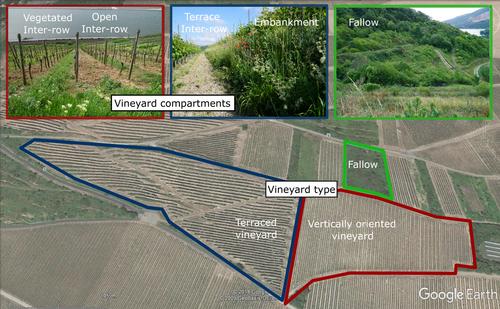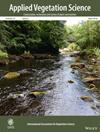Promoting plant diversity and habitat heterogeneity through vineyard terracing
Abstract
Questions
Viticulture on steep slopes has shaped the landscape and biodiversity in many regions, but insufficient profitability has led to management cessation and shrub encroachment. A solution to maintain economically viable cultivation could be vineyard terracing. We aimed to identify the potential of terracing to enhance plant diversity and habitat heterogeneity in vineyards, analyze effects of management intensity on vineyard vegetation, and assess how plant communities change after vineyard abandonment.
Location
Wine-growing region of the Upper Middle Rhine Valley in Hesse (50.042342° N, 7.814533° E) and Rhineland-Palatinate (50.119139° N, 7.719275° E), Germany.
Methods
We recorded vascular plant species and local vineyard parameters in vertically oriented vineyards with vegetated and tilled open inter-rows, in terraced vineyards with tilled terrace inter-rows and extensively managed embankments, and in vineyard fallows in a total of 45 study sites. We used plant species richness, Ellenberg indicator values and Grime's strategy types to describe how traits and ecological requirements respond to distinct vineyard management.
Results
Plant species richness and composition were determined by management-derived disturbance intensities. Extensively managed embankments had a distinct plant community, the highest plant species richness, more perennial and indicator species, and lower nitrogen indicator values compared with inter-rows. By contrast, highly disturbed open and terrace inter-rows revealed plant communities associated with annuals and ruderals, but species richness did not differ between terrace inter-rows and embankments. The plant communities of fallows were completely different with lower plant diversity.
Conclusions
Our results highlight the potential of terraced vineyards for plant diversity with nutrient poor, extensively managed embankments providing conditions that have become rare in modern agricultural systems. A long environmental gradient from terrace inter-rows to embankments created habitat heterogeneity within a narrow space. By contrast, intensive inter-row management in vertically oriented vineyards hampers high plant diversity and abandonment fosters the spread of woody species at the expanse of plant diversity.


 求助内容:
求助内容: 应助结果提醒方式:
应助结果提醒方式:


